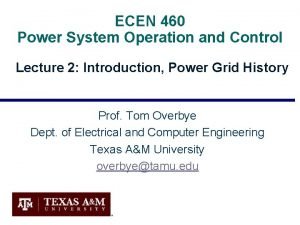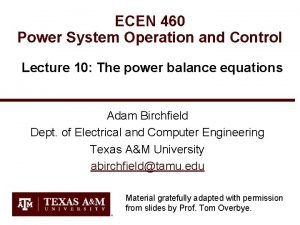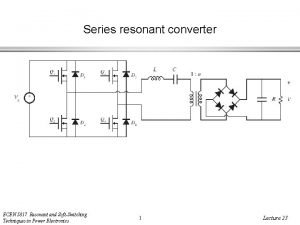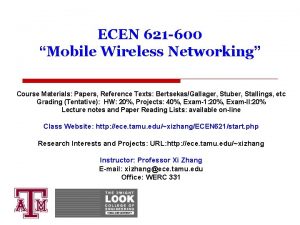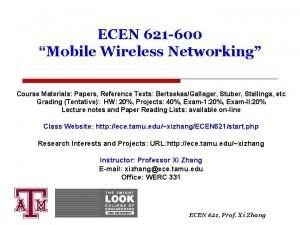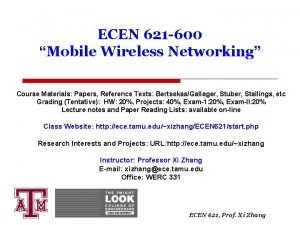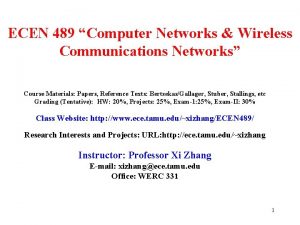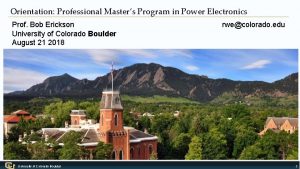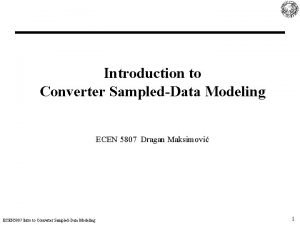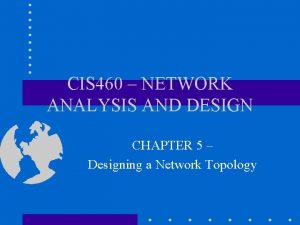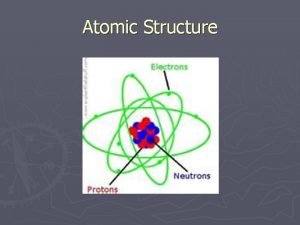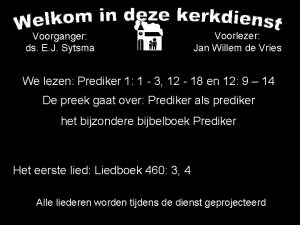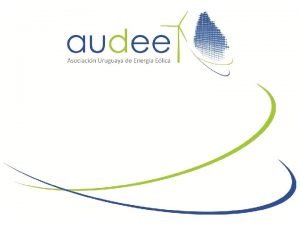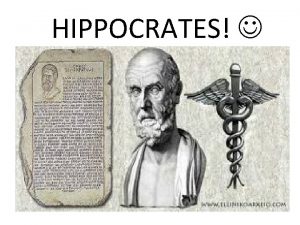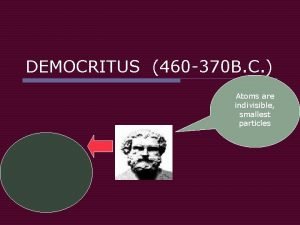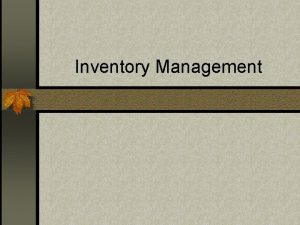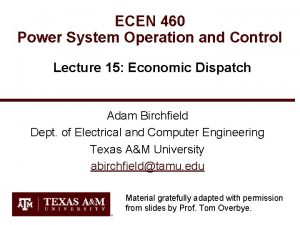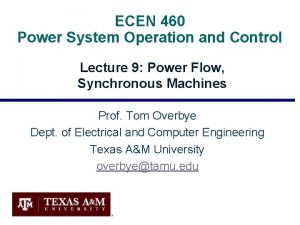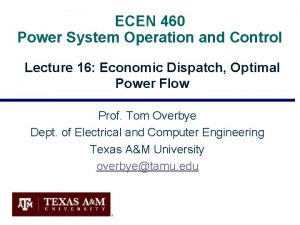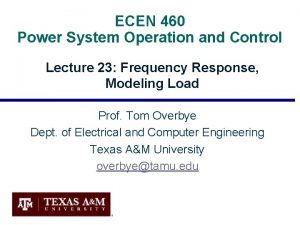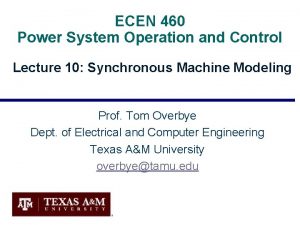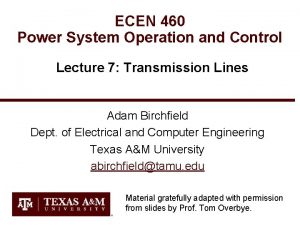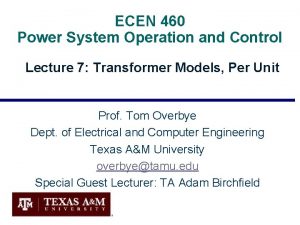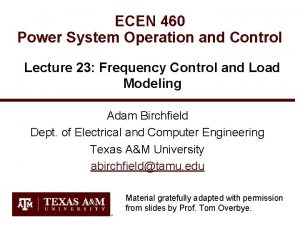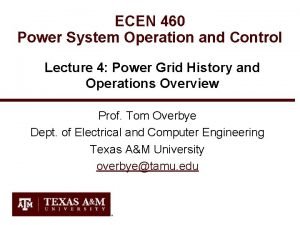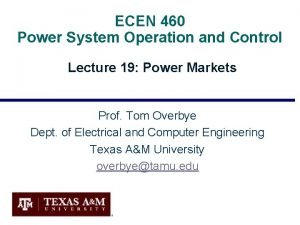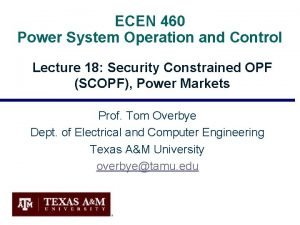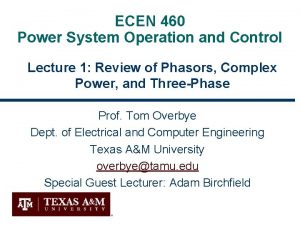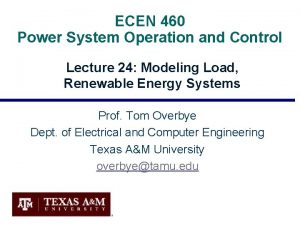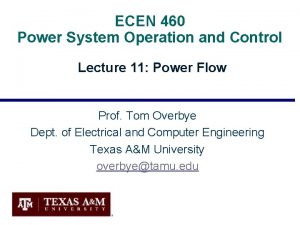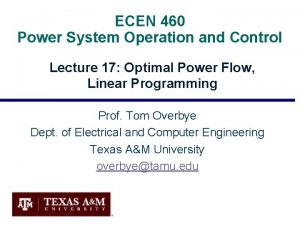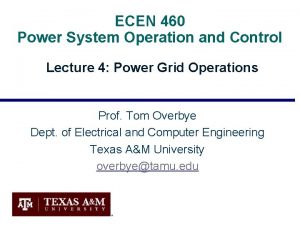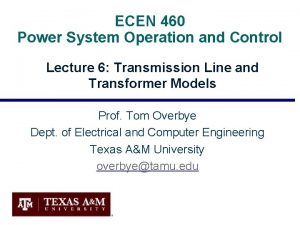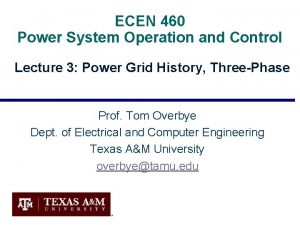ECEN 460 Power System Operation and Control Lecture






























- Slides: 30

ECEN 460 Power System Operation and Control Lecture 13: Power Flow, Contingency Analysis, Power System Control Prof. Tom Overbye Dept. of Electrical and Computer Engineering Texas A&M University overbye@tamu. edu

Announcements • Finish reading Chapter 6 • Homework 5 is 6. 38 (except change the line’s impedance to 0. 02+j 0. 08), 6. 39 (except use the 0. 02+j 0. 08 line impedance, and just do one iteration), 6. 44, 6. 48, 6. 52, 6. 53 • Lab 6 and the following labs will be back in WEB 115 1

Assumed Load Variation in 500 Bus South Carolina Synthetic Grid • In response to the question about the assumed load variation in the 500 bus grid, here is the data. The source was FERC 714 data (which is public utility data). 2

Contingency Analysis Contingency analysis provides an automatic way of looking at all the statistically likely contingencies. In this example the contingency set is all the single line/transformer outages 3

Design Case 1: Serving New Load Assume we need to serve a new 70 MW, 20 Mvar load at 69 k. V 4

Solving Large Power Systems • The most difficult computational task is inverting the Jacobian matrix – – inverting a full matrix is an order n 3 operation, meaning the amount of computation increases with the cube of the size this amount of computation can be decreased substantially by recognizing that since the Ybus is a sparse matrix, the Jacobian is also a sparse matrix using sparse matrix methods results in a computational order of about n 1. 5. this is a substantial savings when solving systems with tens of thousands of buses • We’ll return to large systems once we cover economic dispatch and optimal power flow 5

Modeling Voltage Dependent Load 6

Voltage Dependent Load Example 7

Voltage Dependent Load, cont'd 8

Voltage Dependent Load, cont'd With constant impedance load the MW/Mvar load at bus 2 varies with the square of the bus 2 voltage magnitude. This if the voltage level is less than 1. 0, the load is lower than 200/100 MW/Mvar 9

Dishonest Newton-Raphson • Since most of the time in the Newton-Raphson iteration is spend calculating the inverse of the Jacobian, one way to speed up the iterations is to only calculate/inverse the Jacobian occasionally – – known as the “Dishonest” Newton-Raphson an extreme example is to only calculate the Jacobian for the first iteration 10

Dishonest Newton-Raphson Example 11

Dishonest N-R Example, cont’d We pay a price in increased iterations, but with decreased computation per iteration 12

Two Bus Dishonest ROC Slide shows the region of convergence for different initial guesses for the 2 bus case using the Dishonest N-R Red region converges to the high voltage solution, while the yellow region converges to the low voltage solution 13

Honest N-R Region of Convergence Maximum of 15 iterations 14

Decoupled Power Flow • The completely Dishonest Newton-Raphson is not used for power flow analysis. However several approximations of the Jacobian matrix are used. • One common method is the decoupled power flow. In this approach approximations are used to decouple the real and reactive power equations. 15

Decoupled Power Flow Formulation 16

Decoupling Approximation 17

Off-diagonal Jacobian Terms 18

Decoupled N-R Region of Convergence 19

Fast Decoupled Power Flow • By continuing with our Jacobian approximations we can actually obtain a reasonable approximation that is independent of the voltage magnitudes/angles. • The Jacobian need only be built/inverted once. • This approach is known as the fast decoupled power flow (FDPF) • FDPF uses the same mismatch equations as standard power flow so it should have same solution • The FDPF is widely used, particularly when we only need an approximate solution such as in contingency analysis 20

FDPF Approximations 21

FDPF Three Bus Example Use the FDPF to solve the following three bus system 22

FDPF Three Bus Example, cont’d 23

FDPF Three Bus Example, cont’d 24

“DC” Power Flow • The “DC” power flow makes the most severe approximations: – completely ignore reactive power, assume all the voltages are always 1. 0 per unit, ignore line conductance • This makes the power flow a linear set of equations, which can be solved directly • The advantage is it is fast, and it has a guaranteed solution. The disadvantage is the degree of approximation. However, it is used sometimes. 25

DC Power Flow Example 26

DC Power Flow 5 Bus Example Notice with the dc power flow all of the voltage magnitudes are 1 per unit. 27

Power System Control • A major issue with power system operation is the limited capacity of the transmission system – – – lines/transformers have limits (usually thermal) no direct way of controlling flow down a transmission line (e. g. , there are no valves to close to limit flow) open transmission system access associated with industry restructuring is stressing the system in new ways • We need to indirectly control transmission line flow by changing the generator outputs • Similar control issues with voltage 28

Extreme Control Example: 42 Bus Tornado Scenario 29
 Ecen 460
Ecen 460 Ecen 460
Ecen 460 Ecen 5817
Ecen 5817 Ecen 621
Ecen 621 Ecen 621
Ecen 621 Ecen 621
Ecen 621 Ecen 489
Ecen 489 Colorado boulder power electronics
Colorado boulder power electronics Ecen 5807
Ecen 5807 Power system dynamics and stability lecture notes
Power system dynamics and stability lecture notes Power system dynamics and stability lecture notes
Power system dynamics and stability lecture notes Power system analysis lecture notes
Power system analysis lecture notes 01:640:244 lecture notes - lecture 15: plat, idah, farad
01:640:244 lecture notes - lecture 15: plat, idah, farad Real power formula
Real power formula 460+370
460+370 Apnak bang
Apnak bang 460 punkte abitur
460 punkte abitur Luxury rental cars houston
Luxury rental cars houston Cis460
Cis460 460 democritus atom model
460 democritus atom model Gezang 179
Gezang 179 Hippocrates (460-377 bc)
Hippocrates (460-377 bc) 453 en yakın yüzlük
453 en yakın yüzlük Sen 460
Sen 460 Multis complex shd 460
Multis complex shd 460 St460ts
St460ts Hippocrates was born in 460
Hippocrates was born in 460 Hs 460
Hs 460 Democritus 460 bc
Democritus 460 bc Storage and inventory control in operation plan example
Storage and inventory control in operation plan example Power angle curve in power system stability
Power angle curve in power system stability
